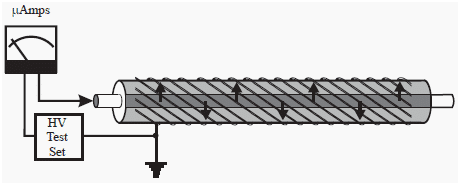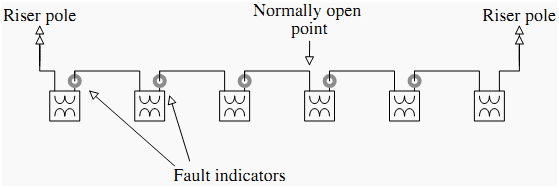
Here’s an article proposed by A.N. who sent us a lot of essays.
Introduction
The effect of a fault cable depends on the type and extent of the fault. Some cable faults reduce the amount of power reaching the load, while an open cable will completely cut off the power to the loads in the affected section.
The method used to test electrical power cables depends on the type of cable, type of fault, power capacity, location of the fault and more. While it is very easy to locate faults on overhead lines, by visual inspections, it is usually difficult for cables in conduits, or the invisible underground cables buried below the earth’s surface.
The common faults are either insulation or resistance related. An insulation test determines the condition of the insulation between the conductor and the screen or another phase conductor, ground or cable at another voltage level.
Cable Insulation and resistance testing
DC high voltage test – Insulation test
A DC high voltage is used to check for insulation problems. When the high voltage is applied to the cable, the amount of insulation leakage current indicates if there are insulation problems.
The cable is considered good as long as this leakage current is within the design limits; otherwise a higher current leakage flow indicates a bad insulation which may require replacement.
Since no insulation is perfect, there will always be some current flow, but this should be very low in the order of microamperes.

Testing cable insulation | image: cablejoints.co.uk
Testing cables using an insulation tester
The testing is carried out using a dual purpose meter such as the Megger insulation tester, which has both the ohmic and insulation resistance ranges. The test instrument is placed between the conductor under test and the ground at the same end of the cable.
The test is then carried out between the phase conductors as well as between each of the conductors and ground to determine the insulation resistance or any short circuits between the conductors..
Loop continuity test
In the continuity test, a short circuit is place between the conductor and the ground at the other end of the cable. With the meter on the continuity range, the measurement is done at the end without a short circuit, between the phase and neutral.
A resistance of over 10 ohms indicates a problem and both the neutral and the conductor should be tested independently using another known good cable which now acts as the return path. An open indicates a broken cable in either the neutral of the conductor. A resistance of over a hundred ohms indicates a corroded cable.
Sectionalizing and testing
This involves testing short distances of the cable, and sometimes requires cutting the insulation at the risk of reducing of the reliability of the cable. The cable is divided into smaller sections until the faulty section determined using a continuity tester or an insulation tester.
This is a labor intensive method and may involve excavation for the underground cables.
Use of faulted circuit indicators (FCIs)
The FCIs are devices that are usually clamped around a conductor so as to measure the fault current through the cable. However, the indicators will only identify that there is a fault in a specific section but cannot pinpoint the exact location.

A typical FCIs application | image: cooperindustries.com
The devices can reduce the time it takes to troubleshoot a fault in the cable, and some even have audible alarms, such that the technicians don’t have to open the cabinets. Once a fault section is identified, other means of pinpointing the fault are employed. Thumping can be used to pinpoint the exact location.
The small devices are used at the padmounted transformers, and some of these provide external visual or audio alarms, hence no need to open the cabinets.
The utility can use the devices on the URD loops, placing one device per transformer.
Thumping
The thumping involves applying a high voltage to the cable under test. This causes a high-current arc that makes a loud noise that can be heard above the ground. The thumping technique eliminates the need to cut and splice the cable as required in the sectionalizing method.
To generate an audible sound that can be heard above the ground, the current must be very high, at several thousand amps and requiring a voltage of about 25KV. This may heat the cable and lead to the degradation of the insulation. However, with good care and experience, the method can provide good results with minimal insulation degradation.
Radar system or Time Domain Reflectometry (TDR)
The TDR technique involves sending a low-energy signal into the cable, and does not cause insulation degradation. This method uses a radar set that sends a short duration pulse of current into the suspect cable. If there is a fault such as a discontinuity, a part of the pulse is reflected back to the radar set. The distance is then calculated using the velocity and time it takes for the wave to propagate to and from the fault.
The method uses a trace to show the approximate distances to the opens, Y-taps, Splices, water ingression and transformers. TDR does not indicate the type of fault nor pinpoint the exact location.
However, the results are usually sufficient in some tests. By narrowing down the fault to a particular section, it acts as a guide for further tests such as thumping to get the exact location with precision.
Using both Radar and Thumper
Since the radar doesn’t pinpoint the exact location, the thumper method can be used to pinpoint the location once the radar gives the approximate location. The thumper voltage pulse breaks down the gap and the corresponding arc is indicated in the trace.
Conclusion
Cable faults may result from environmental degradation, improper handling, insulation, short circuits among other causes. No electrical cable fault should be tolerated and all should be repaired at the earliest opportunity. However, it is not always possible to see the cable faults before they have completely failed or caused some undesirable effects.
For the overhead cables, a visual inspection is enough, however, this cannot be applied to the underground cables, and other methods must be employed to test these. Since there are different types of faults and causes, it is important to know the type of possible fault and the best method, or combination of methods, to accurately locate the fault.
A.N
What’s your opinion on that article? Do you have something to add?
It is important a meter for partial discharges in cable accessories such as (heads, bushings or insulators) in order to improve safety and maintenance.
The reading is an indication of simple intensity level proportional to the probability of the presence of faults in the tested medium voltage device.
Failures in insulation are an important factor in the degradation and reduction of the useful life of a medium voltage component that can be critical. These failures translate into economic risks. It is therefore important that an electric company has an efficient, fast and accessible tool to check the quality and health of its electrical network.
Regards!